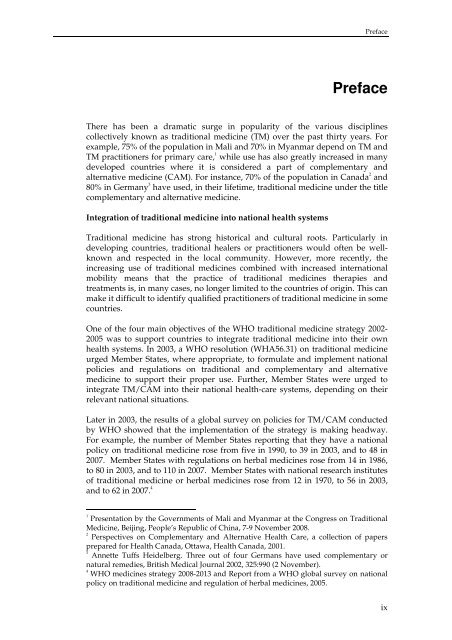Benchmarks for Training in Traditional Chinese Medicine
Benchmarks for Training in Traditional Chinese Medicine
Benchmarks for Training in Traditional Chinese Medicine
You also want an ePaper? Increase the reach of your titles
YUMPU automatically turns print PDFs into web optimized ePapers that Google loves.
PrefacePrefaceThere has been a dramatic surge <strong>in</strong> popularity of the various discipl<strong>in</strong>escollectively known as traditional medic<strong>in</strong>e (TM) over the past thirty years. Forexample, 75% of the population <strong>in</strong> Mali and 70% <strong>in</strong> Myanmar depend on TM andTM practitioners <strong>for</strong> primary care, 1 while use has also greatly <strong>in</strong>creased <strong>in</strong> manydeveloped countries where it is considered a part of complementary andalternative medic<strong>in</strong>e (CAM). For <strong>in</strong>stance, 70% of the population <strong>in</strong> Canada 2 and80% <strong>in</strong> Germany 3 have used, <strong>in</strong> their lifetime, traditional medic<strong>in</strong>e under the titlecomplementary and alternative medic<strong>in</strong>e.Integration of traditional medic<strong>in</strong>e <strong>in</strong>to national health systems<strong>Traditional</strong> medic<strong>in</strong>e has strong historical and cultural roots. Particularly <strong>in</strong>develop<strong>in</strong>g countries, traditional healers or practitioners would often be wellknownand respected <strong>in</strong> the local community. However, more recently, the<strong>in</strong>creas<strong>in</strong>g use of traditional medic<strong>in</strong>es comb<strong>in</strong>ed with <strong>in</strong>creased <strong>in</strong>ternationalmobility means that the practice of traditional medic<strong>in</strong>es therapies andtreatments is, <strong>in</strong> many cases, no longer limited to the countries of orig<strong>in</strong>. This canmake it difficult to identify qualified practitioners of traditional medic<strong>in</strong>e <strong>in</strong> somecountries.One of the four ma<strong>in</strong> objectives of the WHO traditional medic<strong>in</strong>e strategy 2002-2005 was to support countries to <strong>in</strong>tegrate traditional medic<strong>in</strong>e <strong>in</strong>to their ownhealth systems. In 2003, a WHO resolution (WHA56.31) on traditional medic<strong>in</strong>eurged Member States, where appropriate, to <strong>for</strong>mulate and implement nationalpolicies and regulations on traditional and complementary and alternativemedic<strong>in</strong>e to support their proper use. Further, Member States were urged to<strong>in</strong>tegrate TM/CAM <strong>in</strong>to their national health-care systems, depend<strong>in</strong>g on theirrelevant national situations.Later <strong>in</strong> 2003, the results of a global survey on policies <strong>for</strong> TM/CAM conductedby WHO showed that the implementation of the strategy is mak<strong>in</strong>g headway.For example, the number of Member States report<strong>in</strong>g that they have a nationalpolicy on traditional medic<strong>in</strong>e rose from five <strong>in</strong> 1990, to 39 <strong>in</strong> 2003, and to 48 <strong>in</strong>2007. Member States with regulations on herbal medic<strong>in</strong>es rose from 14 <strong>in</strong> 1986,to 80 <strong>in</strong> 2003, and to 110 <strong>in</strong> 2007. Member States with national research <strong>in</strong>stitutesof traditional medic<strong>in</strong>e or herbal medic<strong>in</strong>es rose from 12 <strong>in</strong> 1970, to 56 <strong>in</strong> 2003,and to 62 <strong>in</strong> 2007. 41Presentation by the Governments of Mali and Myanmar at the Congress on <strong>Traditional</strong>Medic<strong>in</strong>e, Beij<strong>in</strong>g, People’s Republic of Ch<strong>in</strong>a, 7-9 November 2008.2Perspectives on Complementary and Alternative Health Care, a collection of papersprepared <strong>for</strong> Health Canada, Ottawa, Health Canada, 2001.3Annette Tuffs Heidelberg. Three out of four Germans have used complementary ornatural remedies, British Medical Journal 2002, 325:990 (2 November).4WHO medic<strong>in</strong>es strategy 2008-2013 and Report from a WHO global survey on nationalpolicy on traditional medic<strong>in</strong>e and regulation of herbal medic<strong>in</strong>es, 2005.ix

















